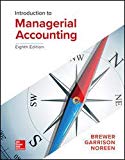
Concept explainers
Break-Even and Target Profit Analysis LO6-6, L06−6
The Shirt Works sells a large variety of tee shirts and sweatshirts. Steve Hooper, the owner, is thinking of expanding his sales by hiring high school students, on a commission basis, to sell sweatshirts bearing the name and mascot of the local high school.
These sweatshirts would have to be ordered from the manufacturer six weeks in advance, and they could not be returned because of the unique printing required. The sweatshirts would cost Hooper $8 each with a minimum order of 75 sweatshirts. Any additional sweatshirts would have to be ordered in increments of 75.
Since Hooper’s plan would not require any additional facilities, the only costs associated with the project would be the costs of the sweatshirts and the costs of the sales commissions. The selling price of the sweatshirts would be $13.50 each. Hooper would pay the students a commission of $1 .50 for each shirt sold.
Required:
1. That level of unit sales and dollar sales is needed to attain a target profit of $1200?
2. Assume that Hooper places an initial order for 75 sweatshirts. What is his break-even point in unit sales and dollar sales?
Target Profit Analysis: It is an analysis of how much unit sales or dollar sales value a company must attain to realize the target profit estimated by the company.
Break-Even Analysis:A break-even analysis is concerned with determining the sales in unit or dollar where a company is neither making profit nor incurring any loss.
1. The required sales in unit and dollar to attain a target profit of $1,200.
2. The break-even point in unit sales and dollar sales when Hooper places an initial order for 75 shirts.
Answer to Problem 24P
Solution:
1. To achieve a target profit of $1,200, Hooper must sell 300 shirts or $4,050 worth of shirts.
2. The break-even point in unit sales is 50 units and dollar sales is $675 when Hooper places an initial order for 75 shirts.
Explanation of Solution
1. Computation of required sales in unit and dollar to attain a target profit of $1,200
2. When Hooper places an initial order for 75 shirts, the cost of the shirt becomes fixed expense as it cannot be returned back. So the variable cost is $1.50 units per shirt which is sales commission for students and the cost of $600 for 75 shirts is the fixed cost of the sales.
Given:
Selling price = $13.50, Variable expenses = $9.50 ($8 cost of sweatshirt and $1.50 for sales commission), there is no fixed cost.
1. Target profit =$1,200
The cost of the shirt becomes fixed expense when an order is place because it is not returnable which means that Hooper has bear this cost even if he does not sell a single unit. But the cost of shirt is variable expense when Hooper is estimating the target profit because the order is not yet placed. The variable expense increase with the increase in the sales unit but the fixed expenses are rigid in nature and remain the same. The contribution margin increases as the difference between the sales revenue and variable expense increases.
Want to see more full solutions like this?
Chapter 6 Solutions
GEN COMBO LOOSELEAF INTRODUCTION TO MANAGERIAL ACCOUNTING; CONNECT AC
Additional Business Textbook Solutions
PRIN.OF CORPORATE FINANCE
Operations Management: Processes and Supply Chains (12th Edition) (What's New in Operations Management)
Horngren's Cost Accounting: A Managerial Emphasis (16th Edition)
Financial Accounting, Student Value Edition (5th Edition)
Principles of Operations Management: Sustainability and Supply Chain Management (10th Edition)
- Sunny Industries reports its accounts receivable on the balance sheet. The gross receivable balance is $42,000, and the allowance for uncollectible accounts is estimated at 15% of gross receivables. At what amount will accounts receivable be reported on the balance sheet?arrow_forwardWhat is the return on equity on these financial accounting question?arrow_forwardNet operating income to increase?arrow_forward
- UI Enterprises purchased a depreciable asset on October 1, Year 1 at a cost of $162,000. The asset is expected to have a salvage value of $18,000 at the end of its five-year useful life. If the asset is depreciated on the double-declining-balance method, what will the asset's book value be on December 31, Year 2?arrow_forwardAbcarrow_forwardDetermine the depreciation for the montharrow_forward
 Managerial Accounting: The Cornerstone of Busines...AccountingISBN:9781337115773Author:Maryanne M. Mowen, Don R. Hansen, Dan L. HeitgerPublisher:Cengage Learning
Managerial Accounting: The Cornerstone of Busines...AccountingISBN:9781337115773Author:Maryanne M. Mowen, Don R. Hansen, Dan L. HeitgerPublisher:Cengage Learning Principles of Cost AccountingAccountingISBN:9781305087408Author:Edward J. Vanderbeck, Maria R. MitchellPublisher:Cengage Learning
Principles of Cost AccountingAccountingISBN:9781305087408Author:Edward J. Vanderbeck, Maria R. MitchellPublisher:Cengage Learning

